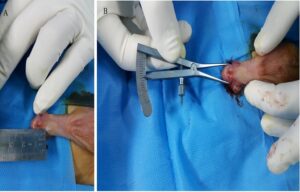Hypospadias Explained: Causes, Symptoms, And Treatment Options

- Hypospadias is a congenital condition where the urethral opening is on the underside of the penis.
- Genetic factors play a significant role, with potential hereditary links and specific gene mutations implicated.
- Environmental factors, such as exposure to endocrine-disrupting chemicals during pregnancy, can increase the risk of hypospadias.
- The critical period for penile development occurs between the 8th and 14th weeks of pregnancy, influenced by male hormones.
- Physical signs of hypospadias can often be detected at birth, allowing for early medical evaluation.
- Psychological impacts, including concerns about self-image and anxiety, can affect children with hypospadias, necessitating emotional support.
- Parents should seek medical attention for urinary difficulties or emotional struggles related to the condition.
- Surgical intervention is typically recommended for correcting severe hypospadias, with various techniques available.
- Non-surgical approaches may be suitable for mild cases, emphasizing careful monitoring and potential hormonal treatments.
- Post-treatment care is critical for recovery, including managing wound care and emotional support for the child.
- The long-term quality of life for individuals with hypospadias can be positive, but ongoing emotional and social challenges may persist.
- Education around sexual health and reproductive concerns is vital as individuals with hypospadias reach puberty.
- Community support and awareness efforts can enhance the quality of life for those affected by hypospadias.
The Intriguing Science Behind Hypospadias: What Happens and Why?
Genetic Factors: The Blueprint of Hypospadias
Hypospadias is a congenital condition in which the opening of the urethra does not occur at the tip of the penis, but rather on the underside. This abnormality can vary significantly in severity, with the urethral opening potentially located anywhere along the shaft to the scrotum. The genetic basis for this condition suggests a multifaceted interplay between various genes and maternal factors. Studies indicate that specific genetic mutations and variations, particularly in genes responsible for androgen receptor functions, may play crucial roles. Additionally, familial cases hint at an inheritable component, where a boy born with hypospadias is more likely to have relatives with the same condition, underscoring the significant influence of genetics in this regard.
Recent research has delved deeper into the genetic architecture surrounding hypospadias, exploring associations with particular chromosome regions. These findings are pivotal as they suggest that early genetic screening may enhance the understanding of the risks associated with hypospadias, allowing for improved interventions and parental counseling. Understanding these genetic blueprints not only offers insight into the etiology of the condition but also aids in directing future genetic research and potential therapeutic avenues.
Environmental Influences: When Nature Meets Nurture
Beyond genetics, environmental factors play a significant role in the development of hypospadias. Exposure to certain environmental toxins, chemicals, and hormones during pregnancy can disrupt normal fetal development, potentially leading to anomalies in genital formation. Notably, endocrine-disrupting chemicals, commonly found in plastics and pesticides, have been identified as potential risk factors. For instance, substances like bisphenol A (BPA) and phthalates, which mimic estrogen, may interfere with normal hormonal signaling during critical periods of fetal growth.
A mother’s health and lifestyle during pregnancy are equally crucial in this discussion. Factors such as maternal smoking, obesity, and diabetes have been correlated with a higher risk of hypospadias in offspring. Understanding the intersection between these environmental influences and genetic predispositions is essential for developing preventative strategies and public health initiatives. Moreover, raising awareness among expectant mothers about minimizing environmental risks can lead to healthier outcomes for future generations.
Understanding the Developmental Timeline: A Window into Fetal Growth
To grasp the complexities of hypospadias, it is important to understand the developmental timeline of male genitalia formation. The critical period for penile development occurs during the first trimester of pregnancy, predominantly between the 8th and 14th weeks. During this time, the presence of male hormones is essential for the proper formation of the penis and urethra. Any disruption to this hormonal signaling during this sensitive window can lead to irregularities, such as hypospadias.
Additionally, the role of testosterone and its derivatives in the morphogenesis of the genital tract is crucial. Disorders in androgen production or receptor sensitivity can impede normal development, leading to a spectrum of conditions from mild hypospadias to more severe forms. Monitoring fetal development through ultrasounds and other technologies can help in identifying potential anomalies, allowing for timely discussions with healthcare providers regarding intervention and management approaches post-birth.
Decoding the Symptoms: How to Spot Hypospadias Early
Physical Indicators: What to Look For in Newborns
Detecting hypospadias at birth is largely based on a comprehensive physical examination by healthcare providers. It is typically one of the more straightforward congenital abnormalities to identify. Parents and caregivers can look for specific signs, including the position of the urethral opening, which may be located anywhere along the penis’ shaft, often nearer to the base than the tip. Additionally, curvature of the penis, a condition known as chordee, may accompany hypospadias, as can abnormalities in the appearance of the scrotum or the overall penile structure. Understanding these indicators can empower parents to seek early medical evaluation and management.
The degree of sense in identifying these physical indicators can profoundly influence early intervention outcomes. Depending on the severity, treatment may be necessary to correct the positioning of the urethra or any associated conditions. Consequently, early diagnosis offers the best chance of minimizing complications associated with the condition, paving the way for optimal physical and psychological development.
Psychological Impacts: Beyond the Physical Symptoms
While hypospadias is primarily a physical condition, its psychological impacts can be equally significant. Concerns about physical appearance and potential stigma can influence a child’s self-esteem and mental health as they grow. As a child moves through stages of development, they may experience anxiety about their condition, especially during social situations, such as school or physical education classes. The psychological burden can manifest in various ways, including social withdrawal, anxiety, or even depression.
The necessity for psychosocial support is vital from an early age to mitigate these potential feelings of alienation or embarrassment. Parents, healthcare providers, and educators can work collaboratively to ensure that children with hypospadias receive the necessary emotional support, fostering open communication about their condition and encouraging positive self-identity. Furthermore, increasing awareness and education surrounding the condition can alleviate stigma, creating a more inclusive environment for affected individuals.
When to Seek Medical Attention: Guidelines for Concerned Parents
Parents may find themselves uncertain about when to consult a medical professional regarding suspected hypospadias. Understanding the guidelines for when to seek medical attention is key. Typically, a physical examination at birth will reveal any abnormalities, and if hypospadias is diagnosed, a referral to a pediatric urologist is warranted. However, if parents observe any signs of urinary difficulties, such as difficulty urinating or recurrent urinary tract infections, they should seek immediate medical care. Parents should also remain vigilant for any emotional struggles their child may face as they grow, prompting the need for ongoing support and potentially therapy.
Prompt identification and referral to specialists can ensure that appropriate management plans are established as early as possible. Regular follow-ups and assessments throughout childhood are crucial, allowing for optimal monitoring of urinary function, sexual development, and psychological well-being.
Navigating Treatment Options: Tailoring Solutions for Every Case
Surgical Procedures: The Art of Corrective Techniques
Surgical intervention remains the mainstay for treating hypospadias, particularly in cases where the urethral opening is not located at the tip of the penis. The timing of surgical intervention typically occurs between 6 and 18 months of age, optimizing the chances of favorable outcomes while minimizing the emotional impacts of waiting until the child is older. Surgical techniques generally focus on repositioning the urethral opening and correcting any associated penile curvature.
Various surgical methods exist for treating hypospadias, including the TIP (tubularized incised plate) procedure, the onlay flap technique, and the Mathieu procedure, each tailored to individual anatomical needs and severity of the condition. These procedures require careful planning and skilled execution to achieve desirable functional and aesthetic results. Post-operative care is crucial, with parents advised on wound care and monitoring for any complications, including infection or re-stenosis. The success of surgery in restoring normal urinary function and penile appearance can significantly improve a child’s confidence and quality of life.
Non-surgical Approaches: A Holistic Perspective on Management
In some cases of mild hypospadias, a non-surgical approach may be advocated, particularly in children who present with minimal abnormalities and no functional issues. These approaches may involve careful monitoring and observation over time, allowing the child to reach an age where surgical methods can be more effective if necessary. Interventional strategies may incorporate hormonal treatments, although these are less common and typically considered for specific cases where other contributing factors play a role.
Therapeutic counseling and educational interventions can also play a role in comprehensive management. Parents should be equipped with knowledge regarding the condition and encouraged to engage in discussions with their child about any questions or concerns. Psychological and emotional support mechanisms can significantly improve overall outcomes, ensuring that children feel empowered and informed about their health.
Post-treatment Care: Ensuring Successful Recovery and Development
Following surgical correction of hypospadias, ensuring optimal post-treatment care is essential to facilitate healing and minimize complications. Parents must adhere to post-operative instructions regarding wound care, including keeping the area clean and dry, monitoring for signs of infection, and watching for any urinary complications. The healing process may require follow-up visits to check for successful outcomes and urinary function.
Moreover, ongoing support and reassurance play critical roles in a child’s emotional recovery post-surgery. Parents should remain attentive to any feelings of anxiety or discomfort their child may express and be proactive in fostering an open dialogue about their experiences. A holistic approach to care, incorporating both physical healing and emotional support, can significantly enhance recovery outcomes, promoting healthy development as the child grows.
Living Awkwardly: The Long-Term Outlook for Individuals with Hypospadias
Quality of Life: Addressing Social and Emotional Well-being
The long-term outlook for individuals born with hypospadias can vary widely based on treatment interventions and individual experiences. Many individuals who undergo corrective surgery lead normal, healthy lives, achieving positive psychosocial outcomes. However, there remains a need to be vigilant about the potential for lingering emotional and social challenges. Feelings of embarrassment or insecurity regarding bodily differences can persist into adolescence and adulthood.
In addressing these challenges, fostering self-esteem and body positivity is paramount. Support groups and psychological counseling can provide safe spaces for individuals to express their feelings, concerns, and experiences. Furthermore, educating peers and fostering understanding in social settings can help to diminish stigma, creating a more inclusive environment for those affected by hypospadias. Understanding and addressing quality of life issues extends beyond mere physical health; it encompasses the entirety of an individual’s well-being.
Future Considerations: Sexual Health and Reproductive Concerns
As individuals with hypospadias reach puberty and engage in discussions surrounding sexual health, it is crucial for healthcare providers to address potential reproductive concerns. In some cases, individuals may experience difficulties with sexual function or fertility, depending on the severity of their condition and the success of surgical interventions. Educating individuals about these issues can prepare them for navigating relationships and discussing their health with partners.
Post-operative assessments regarding sexual health and function are essential components of long-term care for individuals with hypospadias. Regular evaluations can help address any concerns proactively, providing reassurance and effective management strategies when needed. Open communication with healthcare providers about sexual health, function, and fertility is critical in promoting overall health and well-being throughout life.
Community and Support: Building Networks for Better Understanding
Community support plays a vital role in enhancing the quality of life for individuals with hypospadias. Connecting with support groups, both in-person and online, can foster a sense of belonging and understanding among individuals with shared experiences. These communities can provide valuable resources, educational materials, and emotional support that empower families and individuals as they navigate the complexities of the condition.
Furthermore, raising awareness within broader social contexts can contribute to a more informed society. Educational campaigns targeting schools, community organizations, and healthcare providers can debunk myths surrounding hypospadias, fostering greater empathy and understanding. By building comprehensive support networks and promoting community awareness, we can work towards creating an environment where individuals with hypospadias feel accepted, understood, and supported throughout their journeys.
FAQ
Question: What is the typical age for surgical intervention in hypospadias cases? – Surgical intervention is generally recommended between 6 and 18 months of age to optimize outcomes while minimizing emotional impacts on the child.
Question: Are there any long-term psychological effects associated with hypospadias? – Yes, individuals with hypospadias may experience long-term psychological effects, including concerns about self-image and potential stigma, which can impact their emotional well-being into adolescence and adulthood.
Question: How does the severity of hypospadias determine treatment options? – The severity of hypospadias can guide treatment choices, with more severe cases typically requiring surgical correction, while milder cases may be managed non-surgically through observation and monitoring.
Question: Can hormonal treatments be part of the management plan for hypospadias? – In certain instances, hormonal treatments may be considered, especially for specific cases of mild hypospadias, although they are less common than surgical methods.
Question: What role do support groups play in managing hypospadias? – Support groups provide emotional and educational resources, connecting individuals and families who share similar experiences, which can help them navigate the challenges associated with hypospadias.
Question: How can parents help address the emotional needs of a child with hypospadias? – Parents can foster open communication, provide emotional support, and advocate for their child’s needs at school and in social settings to help mitigate feelings of anxiety or alienation.
Question: What are the signs that a child might need medical attention for hypospadias? – Parents should seek medical attention if they observe signs of urinary difficulties, such as trouble urinating or recurrent urinary tract infections, or if they notice emotional struggles in their child.
Question: Is there a genetic component to hypospadias? – Yes, genetic factors can play a significant role in hypospadias, with specific gene mutations potentially influencing the condition and familial cases indicating a possible hereditary link.
Useful Resources
- Mayo Clinic – Comprehensive medical information and resources on various health conditions.
- NIH Eunice Kennedy Shriver National Institute of Child Health and Human Development – Research and information on child health, including congenital conditions.
- HealthyChildren.org – Parental guidance on children’s health and development.
- American College of Obstetricians and Gynecologists – Resources and guidelines related to obstetrics and gynecology.
- Urology Care Foundation – Information on urological conditions, including hypospadias.
- Boston Children’s Hospital – Pediatric healthcare resources and support for families.
- Huggies Australia – Resources for parents on infant health and development, including common conditions.
- American Psychological Association – Resources on mental health, offering insights and support for emotional well-being.







